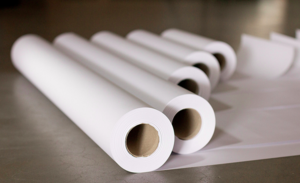Paper

Paper is a material made from cellulose (plant fibres or wood pulp). Paper can also be made from cloth (cotton rag), grasses, hemp, or a mixture of such materials.[1] Paper is usually a flat material, made into sheets for writing, painting, drawing, printing, wallpapering, etc. It is also turned into card-stock, cardboard, manila folders, envelopes and other stationery items. Paper is used to wrap gifts, wipe down kitchen benches, block light, blow noses, do calligraphy, make origami, create craft items (for example, paper pulp can be shaped into bowls or figurines), make lampshades, and so forth.
Paper is made through both industrial processes and by hand. While machinery makes for standard sizes of paper suitable for printers, office work, artwork, and the like, handmade paper is less uniform and more unique, having a range of colours, thicknesses, opacity and textures.
The source of the paper affects its durability, weight and texture. Paper made from wood pulp often requires additives to strengthen it, while paper made from other sources may be sufficiently strong in its own right.
History of paper[edit | edit source]
The Egyptians first used the stem pith of papyrus to serve as a form of paper. This is the source of the word "paper", via the Latin papyrus, derived from the the Greek πάπυρος (papuros).[1]The Chinese appear to have been the first to have invented making paper from pulping, perhaps as early as 105 CE.[1]Museums still contain examples of both Egyptian papyrus sheets and Chinese paper from thousands of years ago.
Handmade paper[edit | edit source]
Paper can be made by hand using recycled paper and/or cloth. In some cases, well dried and processed dung from herbivores can be turned into paper, such as elephant dung paper.[2] Additional items can be added to handmade paper to increase its strength, to add interest to its appearance and to change its colour or transparency. For example, grasses, petals, leaves and different colours of recycled paper can be added to handmade paper for interesting effects.
Paper pulp can be dyed during the paper making process, to change the colours of the final sheets.
Paper making from bark, done by hand - gallery of images[edit | edit source]
This gallery by Shankar S., taken in Luang Prabang, Laos/Lao PDR, shows the process of making paper from bark by hand. Click on each image to enlarge.
-
Step #1: Bark used for making paper by hand.
-
Step #2: Soaking the bark.
-
Step #2a: Shredding the bark by hand.
-
Step #3: Pounding the soaked bark pulp. After this, the pulp is ready to cast into sheets of paper.
-
Step #4: The bark pulp is now ready to be cast into sheets of paper. The rectangular mould creates the sheet shape and the pulp is added in small pieces, then cast or spread across the mesh as it sits in the water bath.
-
Step #4a. Using the mould to shape the paper sheet into a uniform size.
-
Step #4b. Pressing the paper into and across the mould to firm it into the same thin sized sheet all the way across. Keeping the mould in the water helps to keep the pulp thin and pliable. The moulds are then laid out to dry in the sun. When dried, the sheets are lifted off the mould with care.
-
Examples of what is done with the finished product, such as making notebooks and painted paper hangings.







